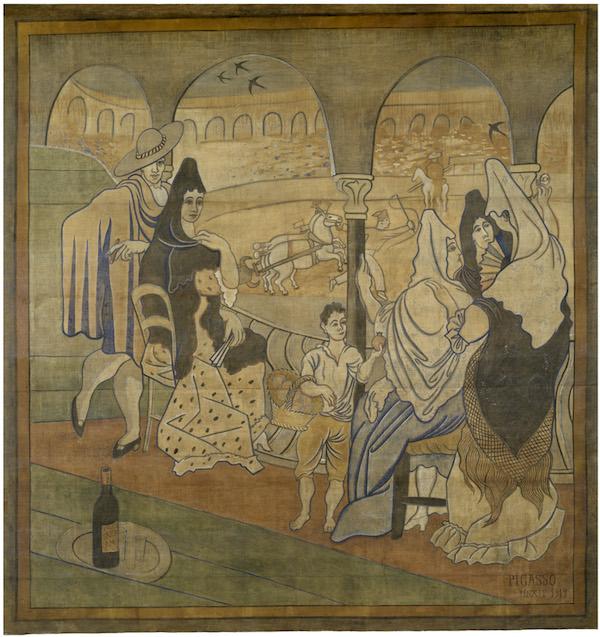Between the Met, Guggenheim, Whitney, and MoMA, it is not hard to quickly name some of New York City’s world-class art museums. If you were then asked where the largest Pablo Picasso work in the United States hangs, you couldn’t be faulted for assuming one of the above. Perhaps surprisingly, however, you would be wrong.
Instead, the massive piece is located at 77th and Central Park West, on the second floor of the New-York Historical Society. Picasso’s Le Tricorne has been an important part of the city’s history for the past 60 years and although the New-York Historical Society is not a traditional art museum, it is the perfect home for the work.

Image credit: New-York Historical Society, Gift of New York Landmarks Conservancy
In 1919, Picasso was commissioned to paint the curtain for a new production from Ballet Russes, a renowned dance company in Paris. The ballet, titled Le Tricorne, or The Three-Cornered Hat, was set in Spain, Picasso’s home country. Due to the size of the curtain, it took Picasso and two other painters three weeks to finish the canvas. Ballet Russes’ focus on modernism and its fame in the art world were not Picasso’s only connections to the troupe. A year prior to the production, Picasso married Olga Khokhlova, a dancer in Ballet Russes. Khokhlova is depicted in the curtain, which first appeared before an audience during the ballet’s premier in London during July of 1919. The ballet got rave reviews, due in part to Picasso’s artwork that emphasized the Spanish setting.
Advertisement
Despite Ballet Russes’ critical success, the company’s owner was out of money by 1928. Sergei Diaghilev turned to one of his most valuable assets, Picasso’s curtain, as a source of quick cash to finance a new production. Diaghilev cut a 20 x 19 foot section out of the center of the curtain and sold it to an art collector. In 1957, the cropped but still large Le Tricorne was bought by Phyllis Lambert and brought to New York. Lambert, the daughter of the Seagram Company CEO Samuel Bronfman, hung Le Tricorne in the Four Seasons Restaurant within the Seagram Building. For the next 55 years, Le Tricorne remained in the Four Seasons and was thought of as “New York’s Picasso,” as it was purposefully visible from the building’s lobby and the Park Avenue sidewalk. The Seagram Company was bought by Vivendi, who would later donated Le Tricorne to the New York Landmarks Conservancy in 2005.
When Aby Rosen’s RFR Holdings purchased the Seagram Building in 2000 for $375 million, change was in the air. Rosen modernized the offices and raised rents before setting his sights on the Four Seasons Restaurant and Le Tricorne around 2014. Rosen publicly stated that he wanted to remove the curtain and even referred to it as a “rag” to the NYLC. The conservancy refused to let Rosen move Le Tricorne, arguing that the aging piece was extremely fragile. Finally, the two parties agreed that RFR Holdings would pay for the restoration and transport of the piece.
Luckily, the New-York Historical Society was aware of the controversy and reached out to the NYLC to offer a home for Le Tricorne. The NYLC was thrilled that the Historical Society would keep the piece in New York City and allow it to remain available to the public. In September of 2014, the massive curtain was carefully rolled up. A year later, Le Tricorne had been restored and was finally hung in the New-York Historical Society, where it remains today.
In 2016, the Four Seasons Restaurant moved from the Seagram Building before closing permanently, largely due to rent increases but perhaps in part because after a nearly 60-year run, “New York’s Picasso” was no longer its centerpiece.



